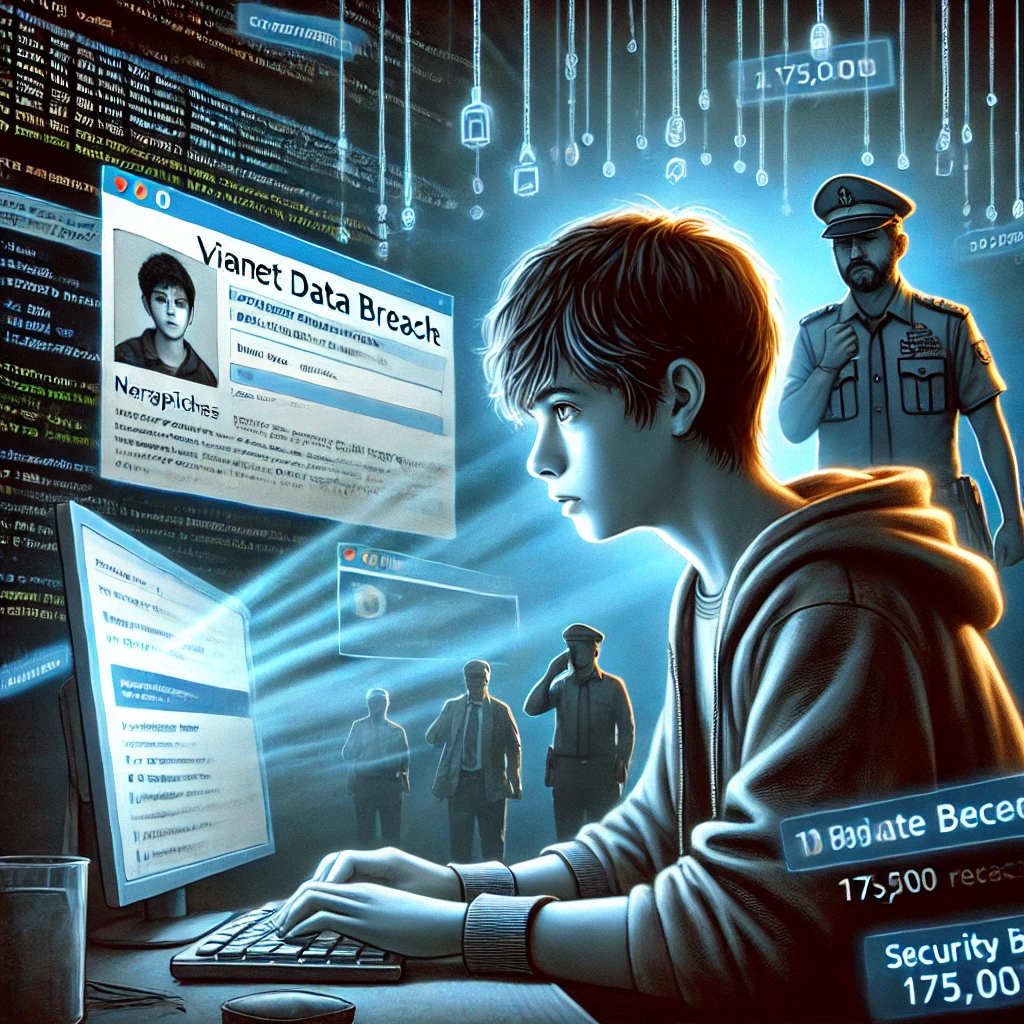Cybercrime’s New Frontier: Our Kids at Risk — An Unseen Threat Right at Home Abhishek Kandel
 Abhishek Kandel
Abhishek Kandel
I’m Abhishek Kandel, and I’m here to share a concerning trend that has emerged in the digital age — the alarming rise of cybercrime targeting children and teenagers. As the world becomes increasingly connected through the internet and social media, our young and impressionable minds have become the new frontier for criminal activity.
Let me paint a picture for you through a series of real-life cases that highlight the dangers our children face in the virtual realm.
Case 1: Cyber Harassment by Pratik
Four years ago, 17-year-old Pratik (name changer) saw a video of his classmate Reeya (name changed) on the popular video app ‘Tiktok.’ What started as innocent interactions and comments quickly escalated into an online romantic relationship, with the two exchanging explicit messages and private photos, despite never having met in person.

When Reeya decided to move on and block Pratik on all social media platforms, he could not handle the rejection. In a fit of rage, he created a fake Facebook account and sent her threatening messages, warning that if she didn’t respond or unblock him, he would post her private photos and videos on the dark web and even confront her parents. Terrified, Reeya reported the incident to the authorities, leading to Pratik’s arrest.
This case highlights the dark underbelly of online relationships, where young, impressionable minds can become entangled in a web of emotional manipulation, blackmail, and cybercrime. Pratik’s actions, driven by a toxic mix of heartbreak and technological know-how, demonstrate the urgent need to educate our children about the dangers that lurk in the digital world.
Think about it: a teenager, barely old enough to vote, was threatening a girl’s safety, leveraging the twisted corners of the internet most of us don’t even understand. And this isn’t just a story — it’s a wake-up call.

The scariest part? This could be happening right now — to someone you know.
We say, “It won’t happen to us.” But the truth is, the most vulnerable in our society — our children — are growing up in a digital age, where mistakes aren’t forgotten, where threats don’t disappear, and where harassment isn’t confined to the schoolyard anymore. It follows them into their homes, into their minds, through the screens they’re glued to.
Case 2: Vianet Data Breach
In 2020, Nepal’s largest data breach occurred when a hacker, a 16-year-old boy named “Narapichas,” exposed over 175,000 records from Vianet Communications Pvt. Ltd. on social media. The teenager claimed that his intent was to highlight the company’s weak data security, not to cause harm.
When confronted by the police, the hacker immediately confessed, acknowledging his wrongdoing and expressing remorse for the breach. He explained that his actions were driven by a desire to send a message to the developers, who often responded with insults and neglect when vulnerabilities were pointed out.

This case underscores the stark reality that even our young, tech-savvy children are not immune to the temptation of hacking and exploiting digital vulnerabilities. While their intentions may not have been malicious, their actions still had serious consequences, both for the company and the individuals whose data was compromised.
It’s not just the hackers we should worry about; it’s the fact that these teenagers, our future, are crossing lines without fully understanding the consequences.
Case 3: Teenagers Post Obscene Videos
In 2020, a disturbing incident occurred when a group of three teenagers, aged 19, 16, and 17, from Bhaktapur were found to be involved in abusing and uploading obscene videos of a transgender individual, Nikisha Shrestha, on social media platforms like YouTube and Facebook. The teenagers claimed that they did not realize their actions were illegal.
In the same year, the Cyber Bureau also uncovered the formation of a Facebook group called “Rapist Organisation,” created by an 18-year-old teenager and joined by others as young as 16 and 17. This group was established in response to a protest against violence against women, further highlighting the disturbing mindset and lack of understanding among our youth.
These incidents demonstrate the alarming trend of our children engaging in the non-consensual production and distribution of explicit content, as well as the creation of online platforms that promote harmful and illegal activities. It’s a wake-up call that our children are not immune to the lure of the digital world and the potential consequences of their actions.
From obscene videos to virtual blackmail, our youth are stepping into a world they’re unprepared for. They’re misusing technology because no one has taught them the real dangers. When we give them smartphones, social media accounts, and unrestricted access, we unknowingly open Pandora’s box. A place where fake accounts, like in Prateek’s case, can ruin lives, where a simple misunderstanding can lead to criminal charges, and where a moment of curiosity turns into years of regret.
Underage Virtual Love
According to the data from the Cyber Bureau, the number of minors involved in both the victim and perpetrator roles of cybercrime is steadily increasing. In the fiscal year 2022/23, 176 minors’ family members filed applications reporting their children as victims of cybercrime, while in the fiscal year 2023/24, the number rose to 635. In the current fiscal year 2024/25, 68 minors’ family members have already visited the Bureau to file such applications. (Source: Gorkha Patra)
Deputy Inspector General (DIG) Nabindra Aryal, head of the Cyber Bureau, explained that these cases often involve teenagers engaging in “virtual love” or online romantic relationships, leading to the exchange of explicit messages, photos, and videos. The curious and impressionable nature of young minds, coupled with the ubiquity of mobile devices and social media, has created a perfect storm for these types of incidents.
A study conducted in 2022 by Voice of Children and EP-Luxembourg in the Kathmandu Valley revealed that 75% of children aged 5 to 12 years old did not know how to protect themselves from online abuse. This is a troubling statistic that highlights the urgent need for comprehensive education and awareness-raising efforts to safeguard our children in the digital age.
The Risk of Virtual Chatting
The problem of cybercrime among minors is not limited to just romantic relationships or data breaches. In a recent incident, a student studying in grade 9 at a famous school in Lalitpur posted a pornographic video of his friend in the school’s student messenger group, demonstrating the widespread nature of this issue.
DIG Aryal noted that the COVID-19 pandemic and the resulting shift to online learning have exacerbated the problem, as mobile phones and social media have become mandatory for education. This has led to a concerning trend where children are spending an excessive amount of time on their devices, often unsupervised by their parents.

Child rights activist Sanjeev Neupane emphasizes the importance of parental involvement, urging them to closely monitor their children’s online activities, from the contacts they maintain to the content they consume and the conversations they engage in. He stresses that parents must be aware of their children’s digital conduct, including the sharing of personal information, passwords, and photographs.
The Way Forward
As a society, we must confront this growing threat to our children’s well-being head-on. The time has come for a comprehensive and multi-faceted approach to address the issue of cybercrime targeting minors.
First and foremost, we must invest in education and awareness campaigns, both for children and their parents. Our young people need to understand the legal consequences of their actions, the importance of online safety, and the risks associated with unguarded digital interactions. Parents, on the other hand, must be empowered with the knowledge and tools to monitor and guide their children’s online activities effectively.
Secondly, we must strengthen the legal framework and enforcement mechanisms to combat cybercrime. Law enforcement agencies, such as the Cyber Bureau, must be equipped with the resources and expertise to swiftly identify, investigate, and prosecute offenders, regardless of their age. The legal system must also adapt to address the unique challenges posed by digital crimes and ensure that the punishment fits the severity of the offense.
Thirdly, we must foster a culture of responsible digital citizenship. Tech companies and social media platforms must take a more proactive role in safeguarding their younger users, implementing robust content moderation policies, age verification systems, and parental control features. Simultaneously, we must encourage the development of digital literacy programs in schools, empowering our children to navigate the online world with wisdom and caution.
By addressing this issue on multiple fronts — education, legislation, and technological solutions — we can create a safer and more secure digital environment for our children to thrive. It is our collective responsibility as a society to protect the vulnerable and ensure that the promise of the digital age is not overshadowed by the perils of cybercrime.
As I conclude my monologue, I urge you all to join me in this crucial endeavour. Together, we can ensure that our children’s digital footprints are marked by their creativity, curiosity, and compassion, rather than the scars of cybercrime. Let’s work towards a future where our young minds can explore the boundless possibilities of the online world with confidence and without fear.
We can’t keep turning a blind eye.
The real threat is not the technology itself. It’s how we’re using it, or rather, misusing it. It’s our lack of awareness, our complacency, that’s putting the next generation at risk.
So here’s my call to you: Get involved. Know what’s happening behind those screens. Before another child becomes a victim — or worse, a criminal.
Let’s stop pretending the cyber world isn’t real. It’s as real as the pain, the fear, and the consequences these kids are living with. Let’s teach them, guide them, and most importantly, protect them. Because if we don’t, who will?
Subscribe to my newsletter
Read articles from Abhishek Kandel directly inside your inbox. Subscribe to the newsletter, and don't miss out.
Written by

Abhishek Kandel
Abhishek Kandel
Self-driven, quick starter, passionate programmer with a curious mind who enjoys solving a complex and challenging real-world problems.